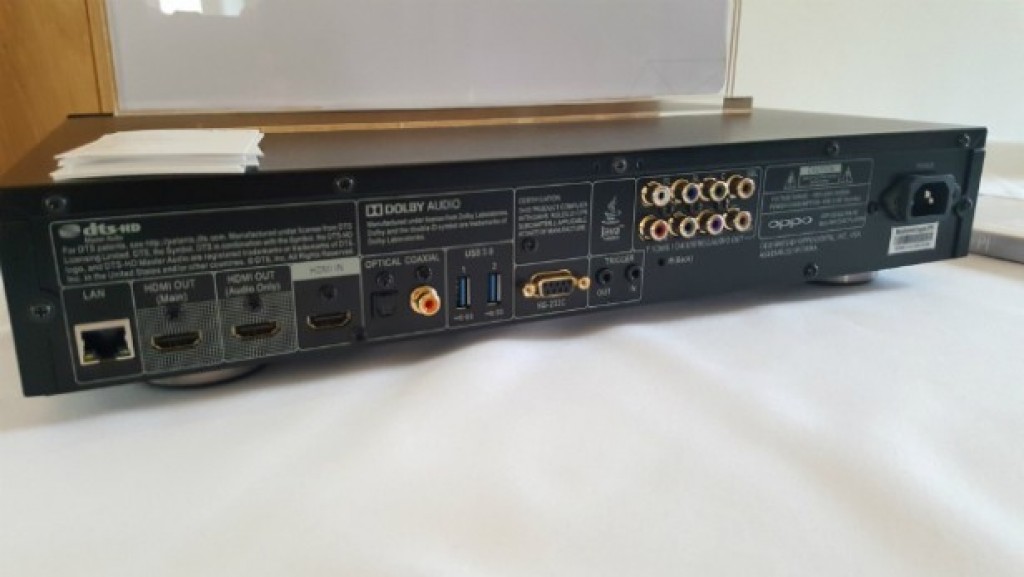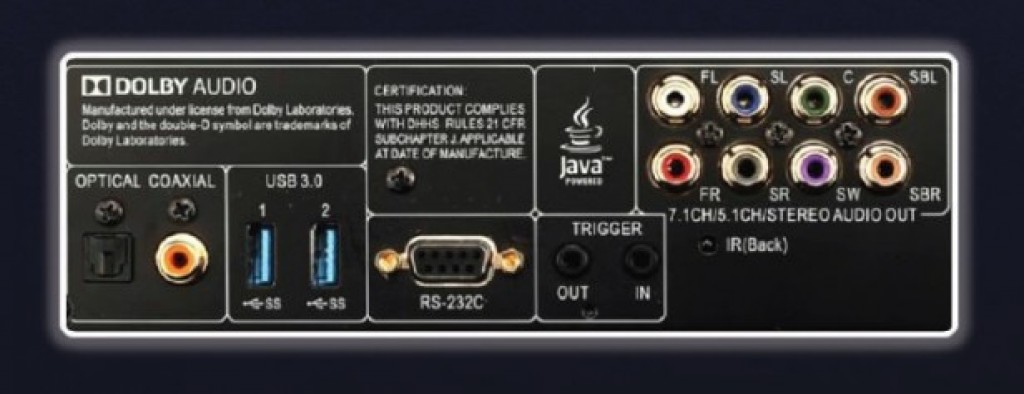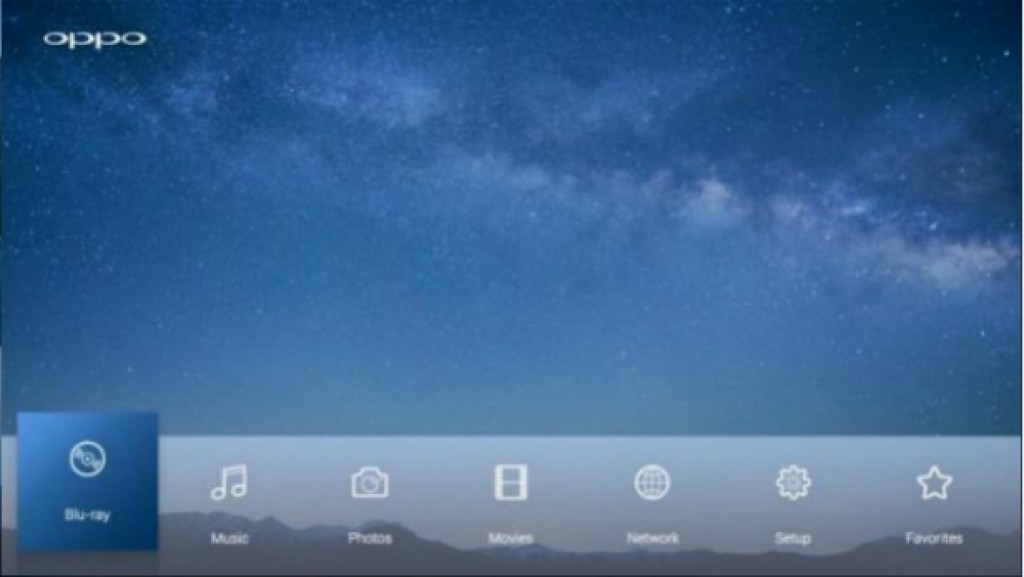
KEY FEATURES
- SoC (System on Chip) UHD Blu-ray decoder
- AKM 8-channel, 32-bit DAC
- Built-in dual-band Wi-Fi
- 2-channel DSD256 and multi-channel DSD64/128 support
- UHD Blu-ray, Blu-ray (2D & 3D), DVD, DVD-Audio, SACD, CD and AVCHD disc playback
- DLNA/SMB media streaming
- Manufacturer: OPPO Digital
- Review Price: £599.00
So far, the Ultra HD Blu-ray player market has been a straight up dogfight between Panasonic and Samsung – and Microsoft if you count the Xbox One S. But now, enthusiast favourite Oppo has waded into the 4K waters with its debut deck – the UDP-203.
The deck is a typically heavyweight affair, boasting the sort of luxurious design and exhaustive spec to make other players look like market stall knock-offs.
Oppo has thrown everything and the kitchen sink into this player, including a new video-processing chip developed with MediaTek that promises industry-leading picture quality. But that’s only to be expected from the company that brought us gob-smacking Blu-ray players such as the BDP-105D and BDP-831.
The only downside is the price – at £599 (TBC), it will join Panasonic’s DMP-UB900 as the most expensive player on the market when it launches in November.

OPPO UDP-203 – DESIGN
With its metal chassis, steel cover and thick, brushed aluminium front panel, the UDP-203 is a remarkably well-made player. It’s rigid and robust – like a slab of black granite. The look is similar to that of the BDP-105D, with a business-like black finish, flush fascia and minimal front buttons. No frivolities; just a serious-looking piece of hardware.

In terms of connections, Oppo usually goes above and beyond the call of duty and the UDP-203 is no exception. The all-encompassing range of gold-plated connectors on the rear includes dual HDMI outputs. The HDMI 2.0 offers full 4K/60p video output, while the HDMI 1.4 port carries audio-only, ensuring compatibility with older AV receivers.

They’re joined by a HDMI 2.0 input, which allows you to pass other native 4K sources such as TV set-top boxes and games consoles through the Oppo. This is a first when it comes to UHD Blu-ray players.


Among the other sockets are 7.1-channel analogue outputs, two USB 3.0 ports on the back, USB 2.0 on the front, optical and coaxial digital outputs, RS-232 and trigger in/out ports for integration with external control systems.
OPPO UDP-203 – SPECIFICATIONS
Oppo takes the same no-holds-barred approach on the inside too. The brains of the player is a new SoC (System on Chip) developed with MediaTek, which delivers “advanced image processing”. The UDP-203 is the first player of its kind to use this chipset.
Its advanced processing also makes the UDP-203 technically capable of supporting Dolby Vision playback, although it isn’t yet certified. Oppo is “in talks” with Dolby, so for now it’s a case of watch this space, but it’s good to see a player built with this capability in mind.
There’s a custom-made 4K disc loader with an optimised laser mechanism for fast disc loading, error-free playback and wide disc compatibility. That includes UHD Blu-ray, Blu-ray (2D & 3D), DVD, DVD-Audio, SACD, CD and AVCHD discs.
Over the years, Oppo’s disc players have been celebrated for their audio quality almost as much as their video prowess, and the UDP-203 shows no signs of letting that slide.
It’s endowed with a premium 8-channel, 32-bit DAC from AKM (4458), with support for PCM, AIFF, ALAC, FLAC and WAV up to 384kHz/32-bit, plus 2-channel DSD256 and multi-channel DSD64/128. The deck also supports Dolby TrueHD, DTS-HD Master Audio, Dolby Atmos and DTS:X.
The UDP-203 can also be used as a media streamer via built-in dual-band Wi-Fi (2.4 and 5.0GHz) or Ethernet. It will play AVI, MKV, MOV, M2TS/TS, MP3, WMA, AAC, AIFF, ALAC, APE, DSD, FLAC and WAV from DLNA/SMB servers on a network. It also plays media from HDDs up to 16TB plugged into a USB port.
The only snag is that the UDP-203 doesn’t offer any video streaming from services such as Amazon or Netflix. This isn’t a huge issue given that most new TVs have these services built in – but even so, it’s one area in which Oppo’s rivals have the upper hand.
OPPO UDP-203 – OPERATION
Oppo has given its menu system a lick of paint. The new high-resolution interface has been designed for maximum convenience, making it easy to find your media. There are dialogue boxes that display detailed information for professional users, while nine zoom modes and fast start-up further enhance the user experience.

Naturally, there’s also HDR to SDR conversion for older TVs that don’t support HDR10 – it can be selected in the setup menu as one of four HDR modes, alongside an option to output HDR with the metadata stripped.
The remote has also been refreshed. The backlight turns on automatically when you pick it up thanks to a built-in accelerometer that detects movement. Otherwise, it looks similar to previous Oppo remotes with its chunky buttons and intuitive layout. There’s a dedicated HDR shortcut key that provides quick access to the menu outlined above.
OPPO UDP-203 – PERFORMANCE
Naturally, we were at the mercy of Oppo’s demonstration setup at the launch, but displayed on an LG OLED TV the pictures on offer looked nothing short of spectacular. Without the Panasonic or Samsung players on hand for an A/B comparison, it’s difficult to tell quite how much more spectacular its images are, but they’re impressive nonetheless.
Oppo’s 4K test disc of choice was Deadpool, and the deck’s colour handling was the first thing to jump out. Deadpool’s tight-fitting suit is rendered in deep, natural-looking shades of red, with smooth, intricate tonal gradation within it.
Also impressive was the deck’s reproduction of detail, which on a subjective level seems to hit new heights of sharpness. The texture of Deadpool’s suit looks remarkably punchy and focused, making it seem almost three-dimensional. Ryan Reynolds’ facial close-ups also reveal gorgeous detail, housed within some of the most natural-looking skin tones I’ve witnessed.
During the freeway shoot-out scene, when Deadpool takes out his foes while counting down his remaining bullets, his motion is fast and fluid, with no juddering or blur.
EARLY IMPRESSIONS
On this evidence, the UDP-203 is shaping up to be a stupendous UHD Blu-ray disc player. It’s the sort of machine John Hammond from Jurassic Park might make, with Oppo sparing no expense to deliver the finest possible performance.
In terms of features it leaves no stone unturned (apart from video-streaming services found on most smart TVs), while its jaw-dropping build quality puts Panasonic and Samsung’s efforts to shame. Its improved operating system, extensive socketry, media streaming and wide-format support are further reasons for optimism.
On first viewing its pictures look staggeringly good, but we’ll reserve judgement until we get our hands on a production sample. But from what we’ve seen so far, there’s every reason to believe that this will be the UHD Blu-ray deck to beat come November.
Sourse: trustedreviews.com










































Interesting, that reference to November availability. I don’t think OPPO has stated/confirmed that yet.
I strongly suspect I’ll be selling my Panny UB900 and getting this. The Panny’s great for playing discs but rubbish for everything else.
I’m surprised about the lack of streaming services though, they’re kinda expected these days. The ones on the Panny are fairly unusable (everything plays at 60Hz) but at least they exist (and might get fixed someday). Luckily my TV has the streaming services built in.
I think most people these days have an extra box for streaming purposes like the ROKU. Those streaming services move too fast in terms of updates compared with the relatively slow hardware cycle of standalone disc players.